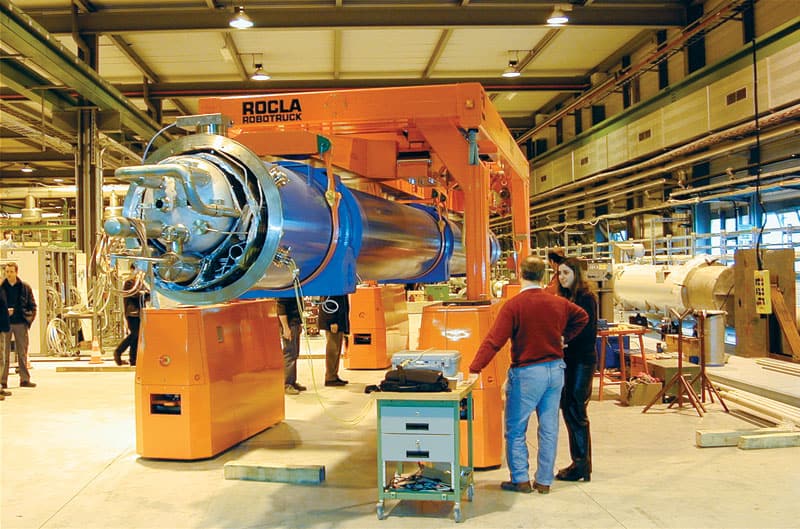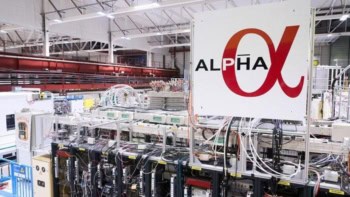CERN’s Large Hadron Collider is finally up and running, but the lab is already planning an audacious upgrade using technology not yet invented, as Matthew Chalmers reports

It is hard to imagine upgrading an instrument as big and complex as the SwFr6.5bn (€10bn) Large Hadron Collider (LHC) at the CERN particle-physics lab near Geneva. The 27 km-circumference collider, which was switched on in September 2008 after 25 years of planning and construction, was built to drive 2808 bunches of protons – each containing about 100 billion protons – into one another 40 million times per second inside four detectors the size of large buildings. A tiny fraction of head-on collisions, physicists hope, will hold clues about nature’s fundamental structure, in particular what gave certain elementary particles their masses.
At full luminosity – a measure of the rate of particle collisions – of around 1034 cm–2 s–1, the LHC beam will store enough energy to melt a tonne of copper as it circulates within a whisker of highly sensitive and expensive components. To protect the accelerator and its detectors from stray protons, the LHC is equipped with around 100 movable carbon or tungsten collimators each with a small slit through which the beam can pass. Yet long before the LHC fired its first protons, CERN was planning ways to produce even more intense collisions that will improve the chances of discovering rare, new particles or forces.
The upgrade to the LHC – dubbed the High Luminosity LHC (HL-LHC) – will pack a beam luminosity more than 10 times the LHC’s design goal: up to 5 × 1035 cm–2 s–1. The HL-LHC will therefore need more sophisticated collimation to avoid unacceptable heat loads and require upgrades to the LHC’s injection system, which currently relies on CERN’s more elderly accelerators and proton transit lines, to ensure beam quality and stability.
More bang for your buck
Lucio Rossi, HL-LHC co-ordinator, says that the project is the main R&D focus for CERN over the next 10 years, the other being the Compact Linear Collider – one possible design for the next big particle-physics experiment after the LHC. “[HL-LHC] will be like turning up the lights in a darkened room from the point of view of the experiments,” he says. The realities of building, commissioning and operating the LHC have meant that its high-luminosity incarnation will not materialize until around 2022, however, with a price tag of around €1bn. Half of this money will go on upgrading the collider and half on refitting the LHC’s four detectors – ALICE, ATLAS, CMS and LHCb – so that they can cope with the HL-LHC’s harsh collision environment.
The LHC was designed to circulate two 7 TeV beams, generating 14 TeV collisions, but initially has been forced to operate at half this value after an unstable magnet interconnect evaporated during high-current tests just nine days after the LHC switched on in late 2008. Intervening in the LHC is no easy task because, when running, it is kept at a temperature of 1.9 K using 130 tonnes of liquid helium to ensure that the niobium–titanium cables that power its dipole magnets are below their superconducting transition temperature.
It takes months to warm the whole machine to room temperature and then to cool it back down, and three long shutdowns are planned during the next decade. The first, in 2013–2014, will involve fixing around 1000 defective interconnects so that the magnets can operate closer to their target bending field (8.3 T), which allows them to carry 7 TeV protons, while all 10,000 joints will be fitted with a lateral restraint to ensure stability. Further improvements are anticipated in the second shutdown, likely to happen in 2017 or 2018, while the HL-LHC and associated improvements in the detectors will mainly take shape during the third long shutdown scheduled for 2021.
As well as almost doubling the number of protons in each bunch, the HL-LHC relies on improved electromagnetic “optics” to bring the beams of protons into collision in the LHC’s four detectors. Two key technologies are under development: high-field superconducting quadrupole magnets that squeeze the beam more tightly in the vertical and horizontal directions; and radio-frequency “crab” cavities that reduce the angle at which the bunches cross.
“The LHC luminosity upgrade is very demanding technologically, with the LHC already representing the apex of 30 years of work worldwide on superconducting magnets,” explains Rossi. “Existing quadrupole magnets go up to 8 T, and it has so far taken six years of solid work by many US teams to build the first 11.5 T prototype, but we need 13 T and an even larger aperture.” The magnets are mostly being developed by researchers at Fermilab in the US in conjunction with staff at CERN. The crab cavities present an even bigger challenge because they have never been used to kick a beam of protons in the transverse direction, not least at a steady rate of 40 MHz. Much of the R&D for crab cavities, which must be compact and have acute phase accuracy, is taking place at the Cockcroft Institute of Accelerator Science and Technology in the UK, with a test cavity that may be installed at the LHC during 2017–2018.
In addition to developing “radiation hard” electronics by making the semiconductor chips and associated hardware able to withstand higher radiation doses, CERN is considering moving power supplies near the detectors as far away from the beam as possible – ideally above ground, as opposed to their current location close to the detectors 100 m underground. The only way to carry the enormous 200 kA currents required is to use superconductors as well. But low-temperature superconductors, such as niobium alloys, are problematic for this application because the liquid helium required to cool them warms because of hydraulic pressure when suspended vertically. Instead, CERN may have to turn to high-temperature superconductors such as yttrium barium copper-oxide materials, which do not require liquid helium to get them into the superconducting state. “Longer high-temperature superconducting cables exist, but none carrying such high currents,” says Rossi.
Detecting more events
The higher collision rate delivered by the HL-LHC demands major modifications to the ATLAS, CMS, ALICE and LCHb experiments, not least to deal with the increased radiation dose that they will suffer. At normal running, the two general-purpose ATLAS and CMS detectors are flooded with the debris from around 20 proton–proton collisions every time two bunches cross, which must be assessed in less than 25 ns (i.e. before the next bunch crossing) by a “trigger” to decide whether or not the collision is worth recording to disk. At the HL-LHC, however, this “event pile-up” will be more like 400 per bunch crossing, requiring much faster front-end electronics and data-acquisition systems.
The innermost layer of the LHC experiments – the semiconductor pixel detectors that track the collision debris just a few centimetres from the interaction region – will be replaced in all four experiments to cope with the onslaught. As well as being more radiation hard, the upgraded trackers will be more granular to reduce occupancy on pixels, for example by using better nanofabrication techniques to create smaller sensitive regions. Without this change, the vital task of picking out which particles are associated with a particular proton–proton collision (so-called vertex reconstruction or “vertexing”) will be impossible.
“Ideally, you would have a zero-mass tracker so that the particles fly through it without losing energy, but that’s not possible,” says Craig Buttar of Glasgow University, who is a member of the UK ATLAS upgrade team. “Plus, you have all the services – the power cables, the optical signals for control and read-out, and the cooling system – to contend with.” Both ATLAS and CMS are considering using pressurized carbon dioxide in place of current fluorocarbons to cool the upgraded inner detectors, for instance, because it takes up less space.
ATLAS researchers plan to add a new pixel layer to its existing tracker during the 2013–2014 shutdown to improve vertex reconstruction, and those working on CMS are planning similar intervention in 2017–2018. “For CMS, the new tracker is an enormous operation because we need to increase the number of channels by a factor of 10 without increasing the power,” says Dave Newbold of Bristol University, who is software co-ordinator for the CMS upgrade. “Even without the luminosity upgrade, though, we would still have to maintain and improve our detectors. We might have spent 15 years building them, but they’re never really finished.”
The LHCb collaboration, which is devoted to the physics of B-mesons, is considering replacing its current particle-identification detector based on Cerenkov light, as well as a new tracker capable of better vertexing, although in general LHCb operates at a lower luminosity than ATLAS and CMS. Plans to upgrade the ALICE experiment, which is designed to study collisions between lead ions during dedicated LHC runs, are only indirectly linked to the HL-LHC because the detector has been optimized for a lead–lead luminosity of 1027 cm–2 s–1.
Despite taking up two decades of R&D at the edge of what is technologically possible, the HL-LHC will not be the end of the story for CERN’s flagship collider: it is the stepping stone to an even more powerful machine perhaps some time in the 2030s incorporating new superconducting magnets with bending fields of 20 T that would allow a beam energy of 16.5 TeV per beam. The magnet technology does not yet exist, but in May 2010 CERN established a working group to explore the High Energy LHC (HE-LHC). With a likely price tag of several billion euros, HE-LHC will also require completely new accelerators to feed it, but the project’s chances of success will depend on what the LHC and HL-LHC discover. “The HE-LHC will happen,” says Rossi, “the question is when?”
- You can download a PDF of the October 2011 Physics World Big-Science Supplement here.




